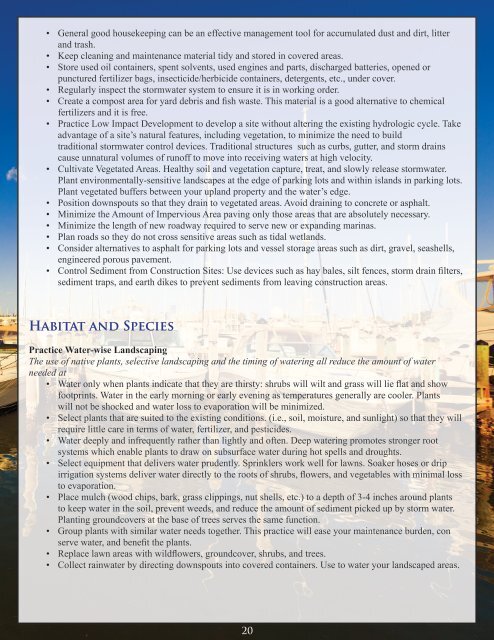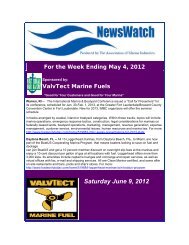Download a copy of AMI's Clean Marina best management practices ...
Download a copy of AMI's Clean Marina best management practices ...
Download a copy of AMI's Clean Marina best management practices ...
Create successful ePaper yourself
Turn your PDF publications into a flip-book with our unique Google optimized e-Paper software.
• General good housekeeping can be an effective <strong>management</strong> tool for accumulated dust and dirt, litter<br />
and trash.<br />
• Keep cleaning and maintenance material tidy and stored in covered areas.<br />
• Store used oil containers, spent solvents, used engines and parts, discharged batteries, opened or<br />
punctured fertilizer bags, insecticide/herbicide containers, detergents, etc., under cover.<br />
• Regularly inspect the stormwater system to ensure it is in working order.<br />
• Create a compost area for yard debris and fish waste. This material is a good alternative to chemical<br />
fertilizers and it is free.<br />
• Practice Low Impact Development to develop a site without altering the existing hydrologic cycle. Take<br />
advantage <strong>of</strong> a site’s natural features, including vegetation, to minimize the need to build<br />
traditional stormwater control devices. Traditional structures such as curbs, gutter, and storm drains<br />
cause unnatural volumes <strong>of</strong> run<strong>of</strong>f to move into receiving waters at high velocity.<br />
• Cultivate Vegetated Areas. Healthy soil and vegetation capture, treat, and slowly release stormwater.<br />
Plant environmentally-sensitive landscapes at the edge <strong>of</strong> parking lots and within islands in parking lots.<br />
Plant vegetated buffers between your upland property and the water’s edge.<br />
• Position downspouts so that they drain to vegetated areas. Avoid draining to concrete or asphalt.<br />
• Minimize the Amount <strong>of</strong> Impervious Area paving only those areas that are absolutely necessary.<br />
• Minimize the length <strong>of</strong> new roadway required to serve new or expanding marinas.<br />
• Plan roads so they do not cross sensitive areas such as tidal wetlands.<br />
• Consider alternatives to asphalt for parking lots and vessel storage areas such as dirt, gravel, seashells,<br />
engineered porous pavement.<br />
• Control Sediment from Construction Sites: Use devices such as hay bales, silt fences, storm drain filters,<br />
sediment traps, and earth dikes to prevent sediments from leaving construction areas.<br />
Habitat and Species<br />
Practice Water-wise Landscaping<br />
The use <strong>of</strong> native plants, selective landscaping and the timing <strong>of</strong> watering all reduce the amount <strong>of</strong> water<br />
needed at<br />
• Water only when plants indicate that they are thirsty: shrubs will wilt and grass will lie flat and show<br />
footprints. Water in the early morning or early evening as temperatures generally are cooler. Plants<br />
will not be shocked and water loss to evaporation will be minimized.<br />
• Select plants that are suited to the existing conditions. (i.e., soil, moisture, and sunlight) so that they will<br />
require little care in terms <strong>of</strong> water, fertilizer, and pesticides.<br />
• Water deeply and infrequently rather than lightly and <strong>of</strong>ten. Deep watering promotes stronger root<br />
systems which enable plants to draw on subsurface water during hot spells and droughts.<br />
• Select equipment that delivers water prudently. Sprinklers work well for lawns. Soaker hoses or drip<br />
irrigation systems deliver water directly to the roots <strong>of</strong> shrubs, flowers, and vegetables with minimal loss<br />
to evaporation.<br />
• Place mulch (wood chips, bark, grass clippings, nut shells, etc.) to a depth <strong>of</strong> 3-4 inches around plants<br />
to keep water in the soil, prevent weeds, and reduce the amount <strong>of</strong> sediment picked up by storm water.<br />
Planting groundcovers at the base <strong>of</strong> trees serves the same function.<br />
• Group plants with similar water needs together. This practice will ease your maintenance burden, con<br />
serve water, and benefit the plants.<br />
• Replace lawn areas with wildflowers, groundcover, shrubs, and trees.<br />
• Collect rainwater by directing downspouts into covered containers. Use to water your landscaped areas.<br />
20












